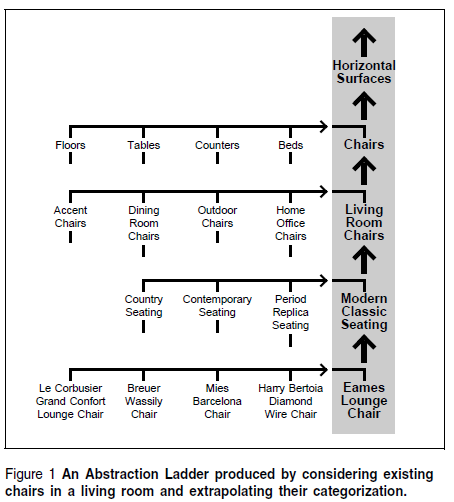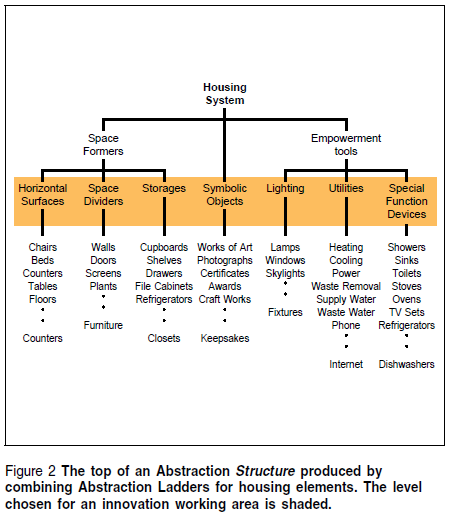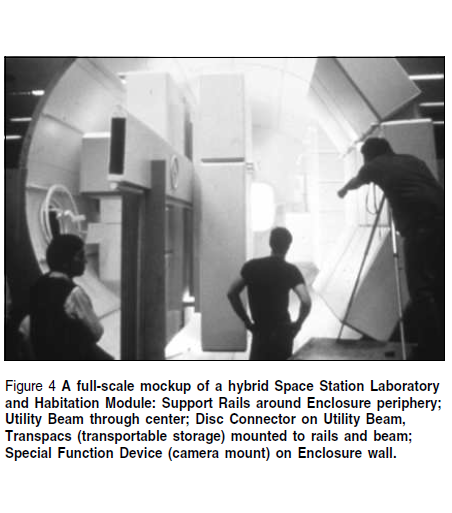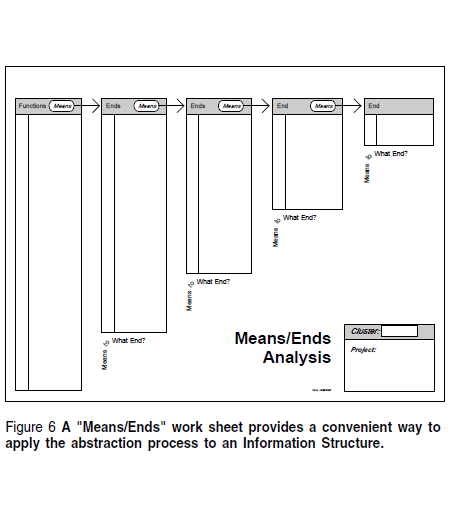The power to abstract is fundamental to innovation. When ideas are scarce, a fresh viewpoint makes all the difference. Abstraction is also a hierarchical process, and that perfectly fits the needs of the innovator facing complex problems requiring system solutions.
The Abstraction Ladder
Abstraction implicitly suggests levels and separation, and “levels” almost immediately extend to multiple levels — a concept visualized nicely as a ladder. The concept was given definition as an Abstraction Ladder by the semanticists Alfred Korzybski and S. I. Hayakawa — Korzybski for the theoretical development and Hayakawa for the popularization in his book Language in Action that made it widely accessible. The steps in abstracting from the specific to the general are the steps of an Abstraction Ladder. Creating one for the purposes of innovation has the objective of defining a series of increasingly abstracted categories from specific elements under study to a level of generality “fresh” enough to encourage alternative lower level categories and new specific elements. As an example, consider innovation in housing design, a difficult topic because we are so familiar with houses.
To rethink the design of a house creatively, we almost have to have a fresh perspective. A cursory examination of components found in a house would list tables, chairs, beds, showers, tubs, washstands, TV sets, lights and so on. In a very short time it would be clear that components can be categorized and can themselves be categories — and that begins the Abstraction Ladder. Tables actually is a category that includes dining room tables, end tables, work tables, bedside tables and more. Chairs includes living room chairs, dining room chairs, office chairs and folding chairs among others. A lower step on the Chair Ladder would contain more specific designs or even brands. As a case in point, the Living Room Chair category might have as specific designs: Eames Lounge Chair, Barcelona Chair and Breuer Chair. Or, if a style level is important, another layer of categories might be inserted to separate modern chairs, contemporary chairs, period chairs and other chair style categories. These could further be subdivided into specific period style groupings recognized in the furniture industry.
At some level, however, the Ladder reaches the bottom. No further subdivision is possible when specific, individual items are reached for which there are distinct names. In practice, the analysis starts at the bottom or somewhere near the middle of a potential Ladder, and the consideration of groupings based on likeness leads to categorization and progression upward in establishing the Ladder (Figure 1).

At the top of the Abstraction Ladder, the direction is always toward greater generalization. Work at this end is harder as more and more insight is required to make categories appropriate and meaningful for the innovation task. For example, a thoughtful consideration of tables, chairs, beds, counters, shelves and floors, would notice that all are horizontal surfaces on which things — or people — rest. Similar consideration of cupboards, cabinets, dressers, drawers, file cabinets, closets, refrigerators and the like would recognize their commonality as storages.
The myriad photos, certificates, awards, art works and sentimental keepsakes decorating a house could be categorized as symbolic objects. At this level of abstraction, an entire household of objects might be characterized as a set of horizontal surfaces, storages, space dividers, lighting, utilities, symbolic objects and special function devices. The individual Abstraction Ladders for all of these, conjoined, create a two-dimensional, hierarchical Abstraction Structure (my term) with both width and depth (Figure 2):

and the housing problem can be reconceived by choice at a degree of abstraction most productive for innovation. Released from the mental restrictions of conventional names and imagery, the innovator can speculate freely upon what a house might be with a new approach to surfaces, storages and the rest of the necessities of home living.
Special Houses — Space Station
In a project done at the Institute of Design for NASA in 1985, the problem was an integrated stowage and logistics system for the Space Station. Using the Abstraction Ladder approach, the design team built an Abstraction Structure that treated the Space Station’s habitation and laboratory modules as special kinds of houses. The abstraction process led to a variant of the model of Figure 2. Not surprisingly, many of the component categories created were similar to or the same as their counterparts in an Earth-bound home or laboratory. The working level chosen from the Abstraction Structure included as physical entities: (1) Enclosure which establishes the environment; (2) Utilities which supply light, power, vacuum, gases, water, air and liquids; and remove waste, trash and CO2; (3) Storages which contain things, organize things and keep things out of the way; (4) Spaces which hold things or crew members temporarily; (5) Special Function Devices which outfit crew and the environment for doing things, and (6) Symbolic Elements which identify, beautify and personalize. Three additional “operational entities” were defined: (7) Configure which arranges and rearranges; (8) Move which introduces, transfers, returns, assembles and disassembles; and (9) Track which locates inventory and keeps record of it. Getting a bit ahead of myself (this article is supposed to be about generating viewpoints, not generating ideas), the nine abstracted concepts were used to set up a generation matrix focused on the project’s specific task of designing a stowage and logistics system (Figure 3).

Of the six physical entities, two (spaces and storages) were primary subjects for design in that model. The remaining four physical and three operational entities were arrayed against them to specify realms for innovation. To give you a partial idea of the result, a mockup of a Habitation/Laboratory Module is shown in Figure 4.

What It Does As Well As What It Is
These examples have used the Abstraction Ladder to describe systems in terms of hierarchies of their actual physical components, drawing on analogous models (existing houses in this case) in which there are many well-defined items from which to abstract. The Abstraction Structures so derived were built with noun-name terms that designate “what it is” (see my article, Capturing Ideas). It is also possible to work with verb forms and a method of designation that is function rather than description based. Such a method concentrates on “what it does”. My article, Covering User Needs, showed that a very good way to create a Function Structure. A Function Structure is an example of a establish a thorough list of criteria for what a system must do is to structure that focuses on what a system does. It is an organization of verb-form operational terms. Because it is built top-down, the Abstraction Ladders are extended downward to find ever more explicit depictions of functionality. When a level is reached where the detail is appropriate to the project, the process is terminated and the structure is complete. As it is, a Function Structure can be used as a “map” for concept development, but as I discussed in Organizing for Innovation, a mapping much better suited to creative thinking can be constructed from the Functions at the bottom of the Function Structure. This structure reassociates the Functions on the basis of their likelihood of being addressed in common by potential solutions (many of which will have been already collected in the process of research). In the Structured Planning process, two computer programs, RELATN and VTCON, assemble a new structure of Functions on the basis of this information — a special kind of abstraction structure called an Information Structure. An example for the planning of an International Design Institute is shown in Figure 5, fresh from the computer analysis.
Means/Ends Analysis
The problem at this point is that the new Information Structure has a well-defined lowest level — the Functions — but no names for the clusters of Functions at levels above, all the way to the top of the structure. At the top, of course, the name is simply the title of the project or projected system. The nodes in between represent clusters in the structure formed by the VTCON computer program as groupings of Functions or lower-level clusters whose association has been determined by numeric calculation of the amount of interaction between Functions. The task is to name the un-named nodes. For Structured Planning, the naming process has been given its own name, Means/Ends Analysis, because each naming step in going from more specific functional elements below in the structure to a next-level higher node is one of establishing the end for which the elements below are the means. Here is where the Abstraction Ladder plays its part. And it comes with an advantage in this application because the structure already exists. The challenge for the innovator (with his or her analyst’s hat on for the moment) is to find thoughtfully insightful category names while moving up the structure.
The overall purpose is the same as previously discussed: to establish a fresh perspective from which to generate fresh solutions. A tool useful for this process is the work sheet shown in Figure 6.

In its pristine form, it is simply a conveniently sized page with places to put Functions and structure from the computer output along with spaces to try out names for inclusion clusters. Graphics remind the user that the flow is from means to ends, increasingly general and abstract. Figure 7 shows a form filled in with information from the shaded region of Figure 5. The shaded boxes indicate where names are to be sought. In the left-most column, Functions are listed in groups corresponding to the clusters they are in. Functions can be in more than one cluster, so they may appear more than once. Node numbers are given in a “level/Cluster” format. 123, for example, is the twenty-third first-level cluster. 213 is the label for level 2, cluster 13. Lines between clusters show the inclusion relationships; Functions or clusters on the left are included in the cluster to which the lines point on the right. In Figure 8, names have been given to the nodes. and the results have been returned to the Information Structure. The structure is now ready to guide the next step of a synthesis process, which will be discussed in a forthcoming article.
Some Final Thoughts
Abstraction is an important factor often overlooked in the innovation process. It can be used formally as we have seen, but it can also be introduced easily as a casual way to change viewpoints. Start with a relevant object, a table for instance in our housing problem. What does a table do? It holds things. What else holds things? A chair. What do they have in common? Quickly the abstracted idea of surface appears. Abstraction has moved the viewpoint to a higher level. Another question: What other functions do things perform in the home? Store things. And another ladder is begun. The key is the deliberate cultivation of wonder in combination with a quest for the essence of function. Abstraction will return to the discussion as we explore how to evaluate complex systems. It has already shown itself, perhaps only teasingly, when we discussed structuring. In my next article it will appear again as a force in reverse for generating ideas.

















